With the timing of your SMS campaigns being so crucial to their performance, we thought it useful to take a look at the data and see when actually is the best day to send SMS campaigns. We’ve discovered some common patterns and trends in our message data which we’ll explore to help you in the planning and scheduling of your future campaigns.
When is the best day to send SMS messages?
At TextAnywhere, we have analysed millions of SMS messages sent by brands & organisations from January 2022 to June 2023. Our objective was to discover which days proved most popular within each industry when it comes to sending SMS messages.
Overall, it appears that the most popular day of the week to send a marketing campaign is Wednesday. Regardless of industry or use case, our customers have sent the most SMS messages on Wednesday compared to any other day of the week..
We’ve broken our data down by our eight largest sectors:
- Healthcare
- Retail
- Financial Services
- Insurance
- Transport
- Utilities
- Recruitment
- Entertainment
So, let’s take a look at what the data has to say about each!
Midweek is popular for healthcare
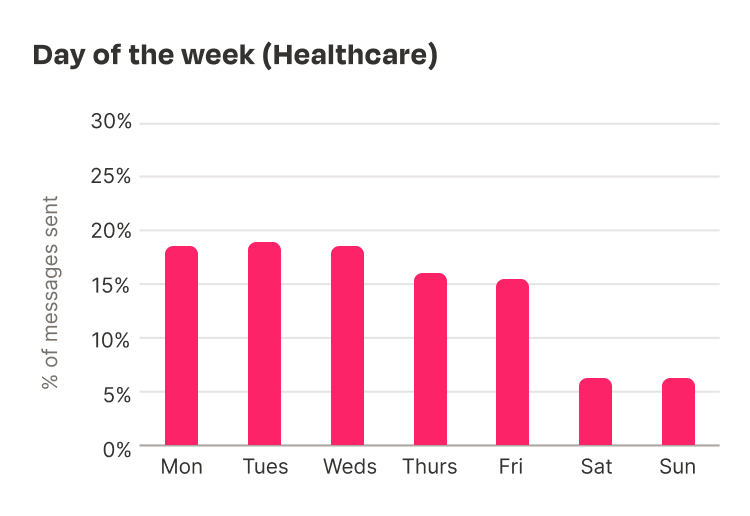
The healthcare industry is a highly active sector which sent millions of SMS messages during this period. With Tuesday and Wednesday sharing the crown, both having 19% share of all messages sent in the healthcare sector, the middle of the working week is the most popular time to send SMS campaigns.
However, as we can see in the data, there’s a consistent downward trend throughout the days of the week. Monday trails right behind Tuesday and Wednesday, holding an 18% share of messages sent. This is followed by a distinct drop on Thursday and Friday. Finished off with a notable downturn at the weekend.
A clear theme, and one we’ll come across several times through this blog, is that weekdays are significantly busier than the weekend. In fact, between Saturday and Sunday, only 12% of SMS messages were sent in the healthcare sector.
However, even though there is a downturn in message volume on Thursdays and Fridays, the share of messages sent in the healthcare industry remains relatively stable across the working week, never dropping below 15% or climbing above 19% of messages sent.
The reason message volume is more consistent across weekdays is a result of a singular dominant use case common in the healthcare sector.
An example of this use case within healthcare is pharmacies who use the platform to notify patients of prescription deliveries. Due to the nature of these messages, they’re typically sent throughout the week at regular intervals. Especially noticeable when compared to other industries who use the platform for more traditional promotional-style messages.
Retail’s favourite day is Monday
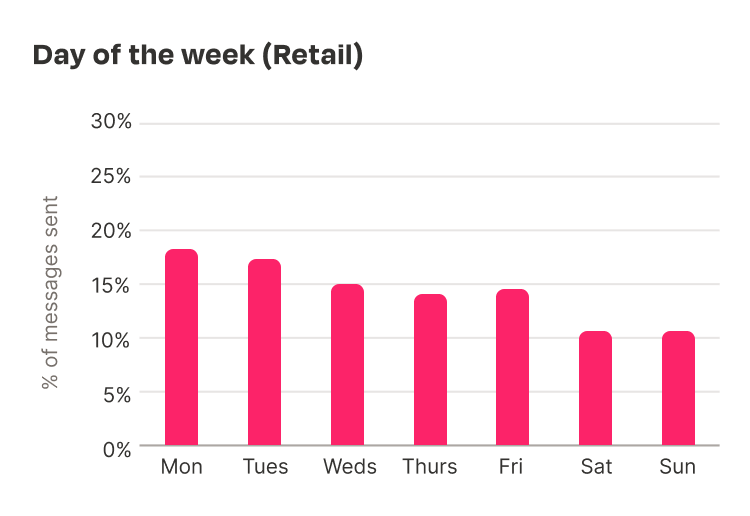
Monday is the close winner for retail, with 18% of the retail industry’s messages being sent on the first day of the week. Interestingly, Tuesday is also a strong day for retail, with Monday and Tuesday taking just less than 40% of all messages between them.
After this, there’s a clear drop off as we progress through the working week. However, Thursday is the least popular weekday, taking only 14% of the share of messages sent.
What does the weekend look like?
Some readers may be surprised at this upon first glance as many would expect more messages to be sent at the weekend by the retail sector compared to the rest of the week in order to encourage consumers to go shopping. However, as most consumers already do the bulk of their shopping at the weekends, retailers find less of a need to send messages on Saturday and Sunday as consumer behaviour already works in their favour.
This is especially the case as retailers tend to favour more promotional messaging: offering discounts, informing of flash sales, etc. But, with much of their business already done at the weekend, there’s less need for aggressive marketing. Whereas consumers are less likely to shop at the beginning of the week, meaning it requires more effort to change that behaviour.
What the data shows is the increased marketing effort to grow sales during these quieter days, with less marketing activities taking place on days where demand is already high.
It’s Midweek madness for financial services
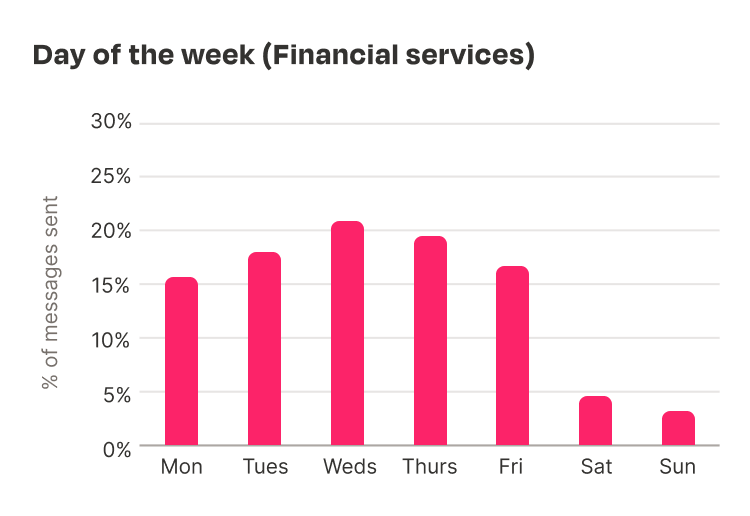
For the financial services industry, Wednesday is the most popular day to send SMS messages. In fact, we see an inverse of the pattern displayed by the retail sector, with a slower start to the week followed by a midweek uptick, and a small downturn before dropping off at the weekend.
By far the most common use of SMS in financial services is for security and authentication purposes. For example, it’s common to receive a single-use code, sent via text, when you log into your banking app, or if you perform a digital transfer.
As customers make use of these services consistently throughout the working week, both professionally and personally, there’s a consistent trend, despite some minor day to day variation, from Monday to Friday. Unsurprisingly, this culminates with a weekend drop; Sunday is the least popular day of the week.
Friday takes the crown for insurance
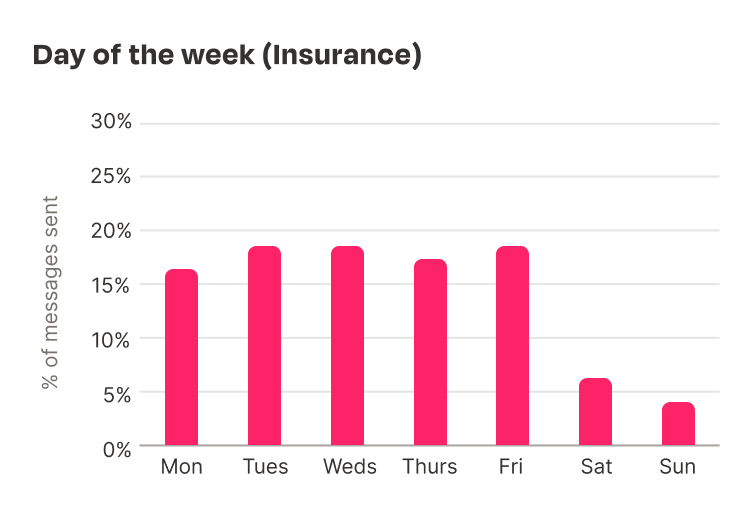
Much like the financial services sector, insurance has a relatively stable distribution of messages across the working week. This is mainly a result of the shared use cases: security and authentication, mainly.
However, one distinct use case for insurance clients which may go some way to explaining why Friday has more volume in comparison to the rest of the financial services sector, is related to insurers specialising in temporary vehicle cover, such as van or car rentals. Their end customers usually require these services at the end of the week.
For example, a customer might rent a van for the weekend in order to move house, then purchase vehicle insurance. The insurance provider would then use SMS to send notifications to customers, such as, a confirmation of their recent insurance purchase.
Saturday is the day for transport
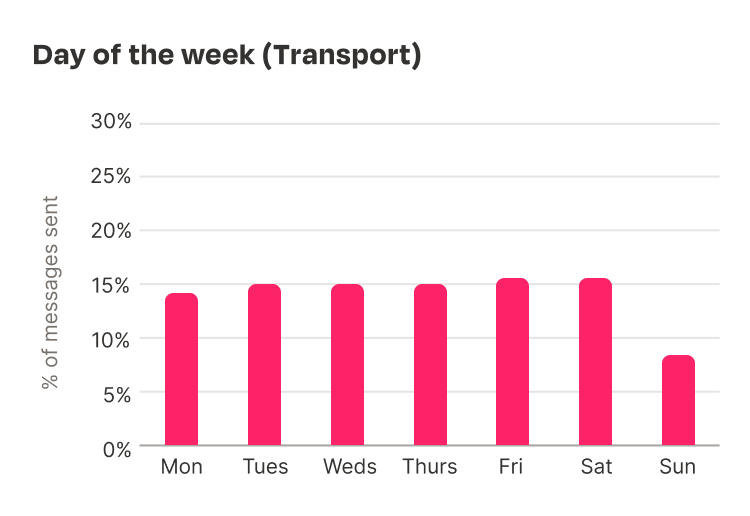
Overall, Saturday is the most popular, but Friday is not far behind. Despite the large variation of companies which fall under the umbrella of “Transport”, it is our most consistently distributed industry. Every day except for Sunday has either a 15% or 16% share of message send volume for this sector.
The bulk of this trend can be attributed to the trends in transport availability in the UK, with nearly every single day being serviced by public transport – trains, buses, trams – with near identical schedules, except for Sundays, where we see significantly less activity.
This is then mirrored across businesses peripheral to core transport companies, such as car parking payments or ticket purchase confirmations. SMS is also commonly used in the transport sector as an internal shift management platform to help companies communicate with employees about working times and shift changes, which are often planned in advance, contributing to the consistency of the messages sent.
Thursday is clear for utilities
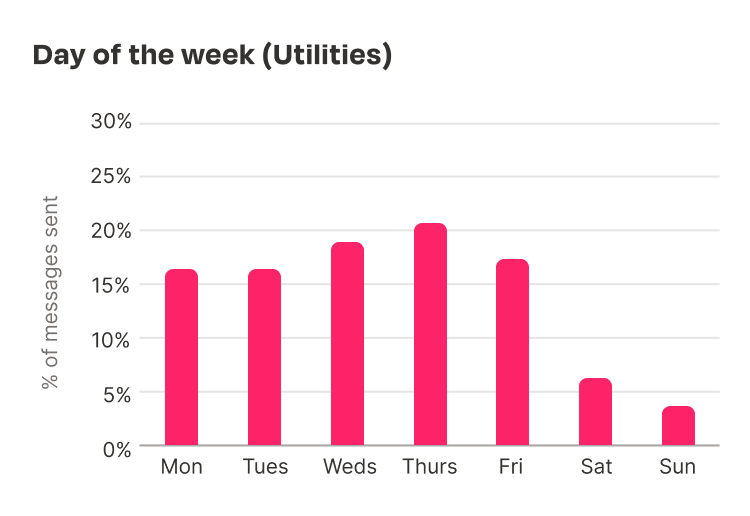
Whilst Wednesday and Friday both see a high share of messages sent within the utilities sector, Thursday is the most popular taking a 21% share of all messages sent. However, the utilities sector is still a relatively stable pattern throughout the working week with the lowest weekdays – Monday and Tuesday – still taking a 16% share.
With water and energy providers, in particular, the main use cases tend to vary between either one-way alerts, such as notifications of electricity usage compared to a customer’s tariff, or two-way conversations used to triage customer service issues.
For example, before speaking to a customer service representative on the phone, a customer may be asked to reply to a text message with a number of options, asking which best describes their issue. This information is then passed on to the employee handling the call to provide additional context to the conversation.
Our end-of-week peak is likely a result of consumers trying to reach out to their utilities suppliers ahead of the weekend as they are aware that contact can be more difficult on Saturdays and Sundays. Unsurprisingly then, we again see a drop off at the weekend as, for the most part, customers would tend to prefer to interact with utilities suppliers during the working week.
Recruitment favours both Tuesdays and Fridays
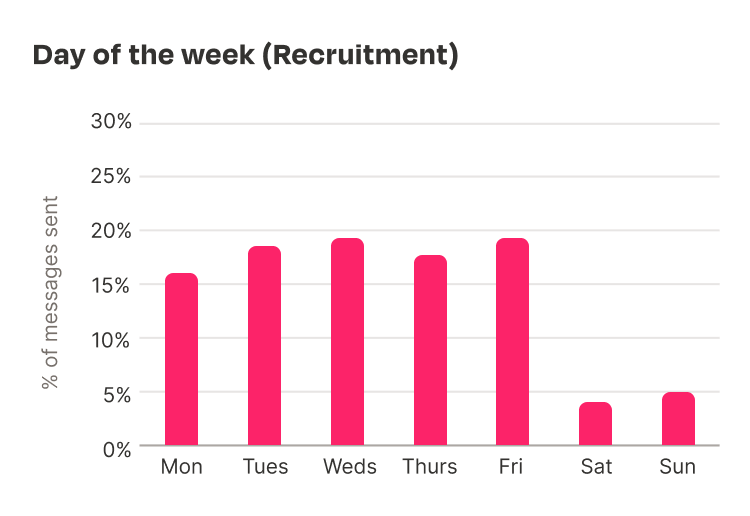
The recruitment industry, like many of those we’ve looked at in this blog, has a relatively even distribution of messages across the working week, with both Tuesday and Friday reigning supreme as most popular. Following this, there is a significant drop in activity with Saturday and Sunday between them making up less than 10% of all messages sent.
The most common use case in the recruitment sector comes from temporary staffing coverage, where SMS is used to inform applicants of shifts available to them, and to gauge interest. In these scenarios, two-way conversational messages are used by the recruiter to send out the details of a job, which the applicant may then reply with YES or NO.
These types of messages make up a large portion of the volume we see in the recruitment industry and explain why we see such strong performance on work days in comparison to the weekend as there is often more work available from Monday to Friday compared to Saturday to Sunday.
An upset in entertainment leaves Tuesday the victor
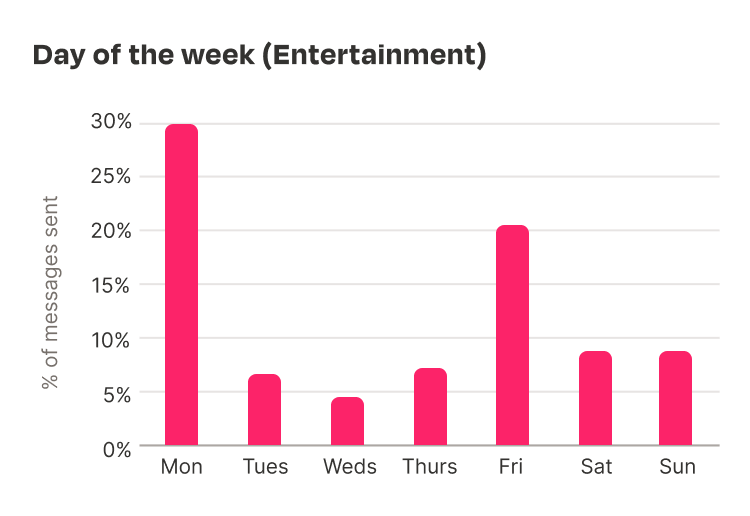
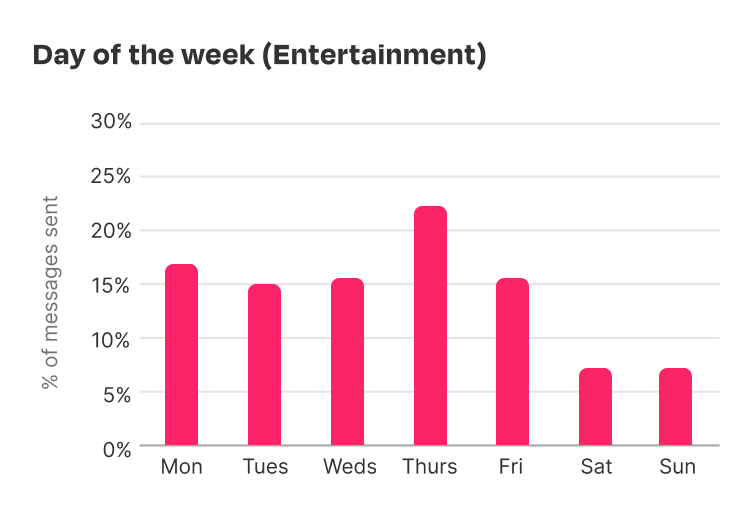
The entertainment industry is another example of a highly diverse sector serviced by SMS marketing. It’s also dominated by more promotional-style campaigns, much like the retail sector. However, the data suggests that when it comes to SMS marketing, the entertainment industry tends to have an “all-or-nothing” approach, with very specific days taking huge portions of the sent messages, whilst other days have almost no activity at all.
However, we must first talk about a significant outlier in our data, for which we have accounted. At first glance, it appears as though Monday is by far and away the most popular day for entertainment companies to send SMS campaigns. But, when we dug deeper it was clear that a singular, high-sending company was skewing the data significantly.
Upon removal of the outlier, we see the trends change significantly across the rest of the week, with Tuesday now being our most popular day to send.
Tuesday takes up 24% of all messages sent in the entertainment industry after the data correction, followed closely by Monday and Thursday, which take 19% and 22% respectively. Across those three days, they make up nearly two thirds of all messages sent in the rest of the entertainment industry.
Conversely, if you combine the volume of messages sent on Wednesday, Friday and Saturday, it only reaches 23% in total. Interestingly, Sunday, with 13% of all sends, has by far the highest share of messages sent on the weekend out of all the industries we’ve looked at. Most likely, this is an attempt to get consumers to spend more time engaged before the start of a new work week when it’s more likely that they’ll spend much less time and money on entertainment compared to the weekend.
Seeing the flexibility business SMS can provide?
Whilst we hope that this breakdown of the data has provided you with some insight into how you can better plan your SMS activities, we also hope it’s helped highlight the range of ways SMS can be utilised across business functions, both internally and externally.
If you’re already using SMS as part of your communication strategy, have you considered how you might be able to expand on your existing usage?
And if you’re not yet using SMS, reach out to start your free trial today!


